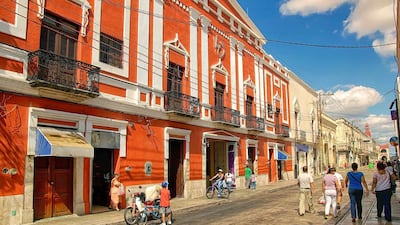Why Mérida?
Mexico’s Yucatán Peninsula is often used as a mass-market, fun-in-the-sun destination. Along the coastal strip, Cancún is packed with high-rise resorts, while Playa del Carmen has a slightly more European feel, and Tulum is more laid-back and bohemian. None of them particularly feel like Mexico, though.
Head inland, and that changes. Mérida, the capital of Yucatán state and the largest city on the peninsula, strikes that perfect balance between accessibility and authenticity. Popular with students learning Spanish and visitors who get itchy feet after a couple of hours on the beach, the city is the region’s cultural heartbeat. It’s also an excellent base for exploring the nearby ancient Mayan ruins and flamingo-packed wetlands.
A comfortable bed
The 14-room Mansión Mérida on the Park (www.mansionmerida.com) is exquisitely beautiful – all glazed-tile floors, stupendously high ceilings, antique furniture and stucco work. All of the rooms have a slightly different look and feel, but there's a general impression that you've been invited into a 19th-century European palace. Rooms cost from US$250 (Dh918) per night.
The Ko'ox Casa de las Palomas (www.kooxhotels.com) is equally distinctive, but in a very different way. It's intimate, built around a small pool and trickling fountains, and goes for a boldly feminine, contemporary look. Rooms cost from US$131 (Dh481).
Find your feet
The main square, Plaza Grande, provides a central focus and many of the city’s main attractions. The insides of Palacio de Gobierno are plastered with rather fabulous murals that act as a visual (and somewhat gory) guide through Mexican history.
Opposite, the Casa de Montejo dates from the 16th century, and goes for a stately home kind of vibe – all rooms with restored rococo, Victorian and neo-Renaissance decor. The cathedral is also worth a look, and from there you can head across to the Museo de Arte Contemporario for art that’s more independent Mexico than colonial times.
Meet the locals
Stroll past most of the city-centre squares during the day, and you may spot temporary stages. Come back in the evening, and you’ll usually find bands or dancers performing on them. The city’s entertainment seems to happen out in the open, and there’s an admirable mix of locals and visitors taking in whatever seemingly randomly crops up every night.
Book a table
La Chaya Maya (www.lachayamaya.com) is a good place to get to grips with Yucatecan cuisine. Relleno negro – turkey in a spicy sauce made with a mystery blend of chillies and spices for 110 Mexican pesos (Dh24) – is a good introduction.
In the birthplace of the poet and statesman Andres Quintana Roo, Amaro (www.restauranteamaro.com) manages to conjure up buckets of romantic atmosphere, especially in its central courtyard, surrounded by billowing trees and plants. Most dishes are local staples, but the likes of tuna medallions in mango sauce for 195 pesos (Dh43) offer something different.
La Tratto (www.trottersmerida.com) is a solid bet if you want to veer away from Mexican dishes. Its terrace on the Plaza Santa Lucia is hugely inviting, and the fettuccine Tuscany with chicken breast, lime and spinach is rather good for 145 pesos (Dh32).
Shopper’s paradise
Mérida is not going to run out of locally made handicrafts any time soon, and the streets around Plaza Grande are the best place for having a browse with a relatively low hassle factor.
Of these, Yaakun on Calle 61 is perhaps the most interesting. It’s run by a cooperative of 600 families, and specialises in brightly coloured woven hammocks and bags. But there’s also plenty of jewellery – made with jade, amber, obsidian and malachite.
What to avoid
Chichén Itza, arguably the most popular of the ancient Mayan sites, is about an hour-and-a-half away. If heading there, set off early and get there as close to the 8am opening time as possible. The difference between seeing it then, in relative peace, and seeing it at 11am, when all the tour buses from Cancún rock up, is immense.
Don’t miss
On the northern outskirts of the city, the Gran Museo del Mundo Maya (www.granmuseodelmundomaya.com) is a big-budget recent addition. It does a superb job of explaining where the ancient Mayan culture took hold and the beliefs and practices it contained. It also delves into today's Maya – which makes up a sizeable chunk of the Yucatán Peninsula's population – and the meteorite that hit the peninsula 65 million years ago. It's the strike that's thought to have wiped out the dinosaurs.
Getting there
Mérida does have a tiny airport, but a better bet is to fly into major hub Cancún, then drive or get a transfer for the three-hour journey to Mérida. Delta (www.delta.com) flies from Dubai to Cancun from Dh5,245 return.
weekend@thenational.ae
Follow us @TravelNational
Follow us on Facebook for discussions, entertainment, reviews, wellness and news.

